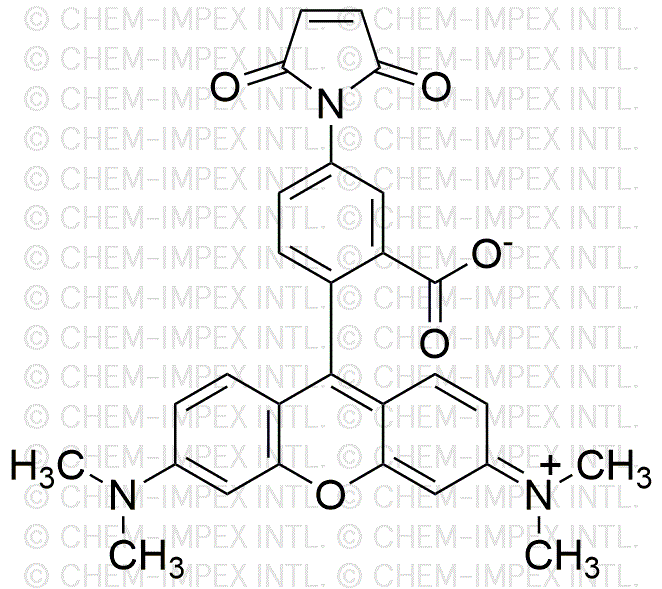Tetramethylrhodamine-5-maleimide is widely utilized in research focused on:
- Fluorescent Labeling: This compound is commonly used to label proteins and other biomolecules in fluorescence microscopy, allowing researchers to visualize cellular processes with high sensitivity.
- Bioconjugation: It plays a crucial role in bioconjugation techniques, where it is attached to antibodies or peptides to create targeted therapies or diagnostics, enhancing specificity in medical applications.
- Cell Tracking: In cellular biology, it is used for tracking live cells in real-time, providing insights into cell migration and behavior, which is vital for cancer research and regenerative medicine.
- Environmental Monitoring: The compound can be employed in environmental studies to detect and quantify pollutants, thanks to its fluorescent properties, making it easier to monitor water quality.
- Drug Delivery Systems: It is also explored in the development of advanced drug delivery systems, where its fluorescent characteristics help in monitoring the release and distribution of therapeutic agents in vivo.
General Information
Properties
Safety and Regulations
Applications
Tetramethylrhodamine-5-maleimide is widely utilized in research focused on:
- Fluorescent Labeling: This compound is commonly used to label proteins and other biomolecules in fluorescence microscopy, allowing researchers to visualize cellular processes with high sensitivity.
- Bioconjugation: It plays a crucial role in bioconjugation techniques, where it is attached to antibodies or peptides to create targeted therapies or diagnostics, enhancing specificity in medical applications.
- Cell Tracking: In cellular biology, it is used for tracking live cells in real-time, providing insights into cell migration and behavior, which is vital for cancer research and regenerative medicine.
- Environmental Monitoring: The compound can be employed in environmental studies to detect and quantify pollutants, thanks to its fluorescent properties, making it easier to monitor water quality.
- Drug Delivery Systems: It is also explored in the development of advanced drug delivery systems, where its fluorescent characteristics help in monitoring the release and distribution of therapeutic agents in vivo.
Documents
Safety Data Sheets (SDS)
The SDS provides comprehensive safety information on handling, storage, and disposal of the product.
Product Specification (PS)
The PS provides a comprehensive breakdown of the product’s properties, including chemical composition, physical state, purity, and storage requirements. It also details acceptable quality ranges and the product's intended applications.
Certificates of Analysis (COA)
Search for Certificates of Analysis (COA) by entering the products Lot Number. Lot and Batch Numbers can be found on a product’s label following the words ‘Lot’ or ‘Batch’.
*Catalog Number
*Lot Number
Certificates Of Origin (COO)
This COO confirms the country where the product was manufactured, and also details the materials and components used in it and whether it is derived from natural, synthetic, or other specific sources. This certificate may be required for customs, trade, and regulatory compliance.
*Catalog Number
*Lot Number
Safety Data Sheets (SDS)
The SDS provides comprehensive safety information on handling, storage, and disposal of the product.
DownloadProduct Specification (PS)
The PS provides a comprehensive breakdown of the product’s properties, including chemical composition, physical state, purity, and storage requirements. It also details acceptable quality ranges and the product's intended applications.
DownloadCertificates of Analysis (COA)
Search for Certificates of Analysis (COA) by entering the products Lot Number. Lot and Batch Numbers can be found on a product’s label following the words ‘Lot’ or ‘Batch’.
*Catalog Number
*Lot Number
Certificates Of Origin (COO)
This COO confirms the country where the product was manufactured, and also details the materials and components used in it and whether it is derived from natural, synthetic, or other specific sources. This certificate may be required for customs, trade, and regulatory compliance.


